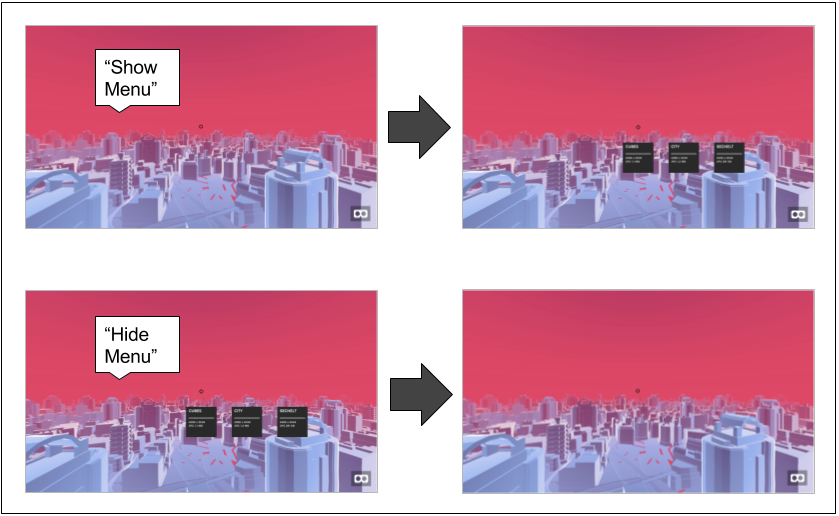aframe-voice-commands v0.1.1

Public Demo
Demos are available publicly at:
https://storage.googleapis.com/aframe-voice-commands.appspot.com/examples/index.html
Image gallery demo
Say "show menu" to bring up menu
Say "go to cubes", "go to city", or "go to lake" to show any of the 3 images
Say "hide menu" to hide menu
This scene is based on the Image Gallery aframe.io demo: https://github.com/aframevr/360-image-gallery-boilerplate
Teleporter demo
Say "start move" to activate raycaster
Say "go to" to teleport to location of marker (with raycaster activated)
Say "cancel move" to deactivate raycaster
This scene is based on the Hello Metaverse aframe.io demo: https://aframe.io/examples/showcase/hello-metaverse/
Overview
The aframe-voice-commands components provide voice commands that you can easily integrate into an aframe scene.
The voice command can set an attribute of a target element, or can also execute a function on a target Component.
The voice-commands.js file defines 2 components:
- A
voice-commandcomponent that can be added to any entity to define an action to take based on a voice command - An
annyang-speech-recognitioncomponent that provides the voice recognition implementation based on the annyang Speech Recognition library: https://github.com/TalAter/annyang
Although this implementation uses annyang for speech recognition, any speech recognition javascript library can be integrated using the same pattern as annyang-speech-recognition
Usage
Adding to aframe scene
To integrate aframe-voice-commands to an aframe scene, the following must be added:
- The
annyangvoice recognition script and the voice-commands.js script
<script src="//cdnjs.cloudflare.com/ajax/libs/annyang/2.5.0/annyang.min.js"></script>
<script src="/components/voice-commands.js"></script>- An entity with the
annyang-voice-recognitioncomponent
<a-entity id="annyang" annyang-voice-recognition></a-entity>- One or more entities with the
voice-commandcomponent
<a-entity id="menu"
voice-command__show="command: show menu; type: attribute; attribute: visible; value: true;"
voice-command__hide="command: hide menu; type: attribute; attribute: visible; value: false;">
...
...
</a-entity>Note that multiple instances of the voice-command component are allowed on the same entity as shown above.
Schema
| Name | Description |
|---|---|
| command | the text of the voice command |
| type | "attribute" to change an attribute or "function" to execute a function |
| targetElement | the component to execute the function on. |
| targetComponent | the element that contains the attribute to change or contains the component to execute the function on. This is optional since by default the target will be entity that the component belongs to. |
| function | the name of the function. For now the function must take no parameters. |
| attribute | the attribute to change |
| value | "the value to change the attribute to |
| keyCode | n optional numeric ASCII code to use as a shortcut (useful for development when quiet is a necessity) |
Example: setting an attribute on target element
<a-entity voice-command="command: city; type: attribute; targetElement: #image-360; attribute: src; value: #city;"></a-entity>Example: executing a function on target Component
<a-entity voice-command="command: go; type: function; targetElement: #cursor; targetComponent: teleporter; function: teleport; keyCode: 13"></a-entity>Browser Compatibility
This implementation is currently only compatible with the Google Chrome browser since it is based on that browser's Speech Recognition API.
This implementation has been tested on Chrome for desktop (Mac OS) and Android, but should also be compatible with the latest Chrome browser on any platform (Windows Desktop, iOS).
Running demos locally
A node.js app is provided here with the Image Gallery and Teleport demos described above.
To run, first execute: npm install
Then execute: npm start
The application will then be running on http://localhost:8080/examples